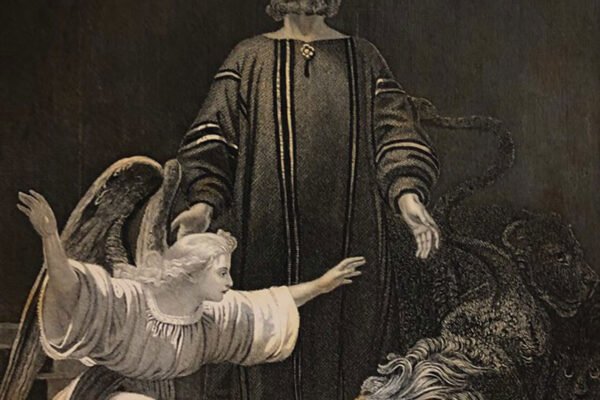My wife and I recently attended a wedding on the bank of a lake overshadowed by steep mountain slopes. The sky, water, and trees provided a gorgeous backdrop. God’s handiwork was the primary decoration, and He did a fabulous job!
As we waited to sign the guest book, we were directed to another line where our photo was taken with a Polaroid camera (yes, they still exist). From the bottom of the camera came a white square of shiny paper. We were told to hold it carefully by the corners until we could hand it to the guest book host.
As my wife and I stood in line, we watched the plain paper gradually transform into an image, grainy and faint at first, but finally resolving into a clear picture of us. It would be placed next to our signatures in the guest book.
Image bearers
As people who have put our hope and trust in the good news of Jesus Christ, we, too, are in the process of becoming an image. God’s plan for the people of the gospel is that they would be transformed by the gospel into the very image of God, as we were created to be (Genesis 1:26, 27).
The author of Hebrews tells us that Jesus is the “exact representation of His [God’s] nature” (Hebrews 1:3). What does Hebrews reveal about the meaning of being created in the image of God?
It says that His image means more than having a certain body structure. Jesus wasn’t significantly different from any of us in His form or appearance. If we had seen Him, Isaiah tells us, there would have been nothing about Him physically that would stand out to us (Isaiah 53:2).
So what was so remarkable about Jesus that distinguished Him as God’s uniquely perfect image bearer? His character, His nature, His sinlessness (Hebrews 4:15). To bear the image of God is to embody His holiness. So we are clearly instructed to “be holy, for I am holy” (1 Peter 1:15, 16), or as Jesus put it, “be perfect, as your heavenly father is perfect” (Matthew 5:48).
Good news
The horror of human history is that we all have fallen short of the glory of God (Romans 3:23). This verse could be understood as saying we have failed the purpose we were created for: to bear the image of God. One way we can understand the gospel is to recognize that Jesus lived the life we were created to live. He carried the image of God in flesh and blood, in time and space, in the way Adam and Eve (and each of us) failed to do.
The good news that makes the gospel so good is that what we failed to do, Jesus grants to us as a gift. In God’s eyes, we are clothed in Jesus’ success, and our failures are wiped from the record books at the cross.
God’s grace gives us more than Jesus’ holy status, however. God’s grace goes on to fill us with the Spirit of God to empower us to actually live as Jesus lived (1 Corinthians 6:19). How can we possibly do this? By allowing God’s indwelling Spirit to produce in us the heart characteristics of Jesus:
But the fruit of the Spirit is love, joy, peace, patience, kindness, goodness, faithfulness, gentleness, self-control; against such things there is no law (Galatians 5:22, 23).
New creation
Here is the astounding glory of the gospel. Because we are vessels created to bear the image of God, the Creator himself has now resumed the work of shaping us into His image — from the inside out. He patiently performs His creative work in us without judgment or condemnation, but with loving craftsmanship, proudly re-creating His image in each disciple of Jesus. These disciples’ highest ambition is to be just like their Master — the exact representation of God’s nature.
We see, then, that the gospel doesn’t just save us from our past sins, or even preserve us for a future glory. It produces a visible transformation in us now — an exceedingly important part of God’s redemptive plan. Because we are ambassadors of God’s kingdom (2 Corinthians 5:20) and representatives of the King of Kings, God’s will for us in Christ Jesus is that we would be accurate revelations of His nature at this exact point in history.
The good news of the gospel is much more than forgiveness of sins, escape from judgment, or even eternal life without pain. An overlooked, yet glorious, work of grace is to be ongoing, with a promise of ultimate completion.
What is the ongoing work?
But we all, with unveiled face, beholding as in a mirror the glory of the Lord, are being transformed into the same image from glory to glory, just as from the Lord, the Spirit (2 Corinthians 3:18).
What is the promise? “I am confident of this very thing, that He who began a good work in you will perfect it until the day of Christ Jesus” (Philippians 1:6).
When will this glorious work be ultimately completed? “Beloved, now we are children of God, and it has not appeared as yet what we will be. We know that when He appears, we will be like Him, because we will see Him just as He is” (1 John 3:2).
In our Sabbatarian churches we often hear that God rested on the seventh day, having completed His work of creation. There is, however, a work yet ongoing, a creative work that is glorious in ambition and gracious in purpose. The gospel includes the offer of the Creator to His creation to fulfill its original purpose, to bear His image.
Like the Polaroid photo at the wedding, we are gradually being transformed by God’s creative power into a glorious image: that of His Son. A powerful part of His invitation to a lost and dying world is to “come taste and see that the Lord is good!” (Psalm 34:8).








